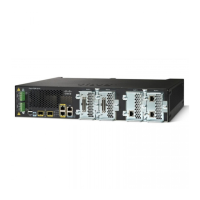29-35
Catalyst 3550 Multilayer Switch Software Configuration Guide
78-11194-09
Chapter 29 Configuring QoS
Configuring Standard QoS
To return a port to its non-trusted state, use the no mls qos trust interface configuration command. To
return to the default DSCP-to-DSCP-mutation map values, use the no mls qos map dscp-mutation
dscp-mutation-map-name global configuration command.
This example shows how to configure Gigabit Ethernet port 0/2 to the DSCP-trusted state and to modify
the DSCP-to-DSCP-mutation map (named gi0/2-mutation) so that incoming DSCP values 10 to 13 are
mapped to DSCP values 30:
Switch# configure terminal
Switch(config)# mls qos map dscp-mutation gi0/2-mutation 10 11 12 13 to 30
Switch(config)# interface gigabitethernet0/2
Switch(config-if)# mls qos trust dscp
Switch(config-if)# mls qos dscp-mutation gi0/2-mutation
Switch(config-if)# end
Configuring a QoS Policy
Configuring a QoS policy typically requires classifying traffic into classes, configuring policies applied
to those traffic classes, and attaching policies to interfaces.
For background information, see the “Classification” section on page 29-5 and the “Policing and
Marking” section on page 29-8.
These sections how to configure a QoS policy:
• Classifying Traffic by Using ACLs, page 29-36
• Classifying Traffic on a Physical-Port Basis by Using Class Maps, page 29-39
• Classifying Traffic on a Per-Port Per-VLAN Basis by Using Class Maps, page 29-41
• Classifying, Policing, and Marking Traffic by Using Policy Maps, page 29-43
• Classifying, Policing, and Marking Traffic by Using Aggregate Policers, page 29-49
Step 6
mls qos dscp-mutation
dscp-mutation-name
Apply the map to the specified ingress DSCP-trusted port.
You can apply the map to different Gigabit-capable Ethernet ports.
However, on 10/100 Ethernet ports, you can attach only one
DSCP-to-DSCP-mutation map to a group of twelve ports. For example,
Fast Ethernet ports 0/1 to 0/12 are a group, Fast Ethernet ports 0/13 to
0/24 are a group, Gigabit Ethernet 0/1 is a group, and Gigabit Ethernet
0/2 is a group. When applying a mutation map to any port in a group,
all ports in the same group are automatically configured with the same
map.
Step 7
end Return to privileged EXEC mode.
Step 8
show mls qos maps dscp-mutation Verify your entries.
Step 9
copy running-config startup-config (Optional) Save your entries in the configuration file.
Command Purpose

